Keyword Density: What It Is and How to Calculate It
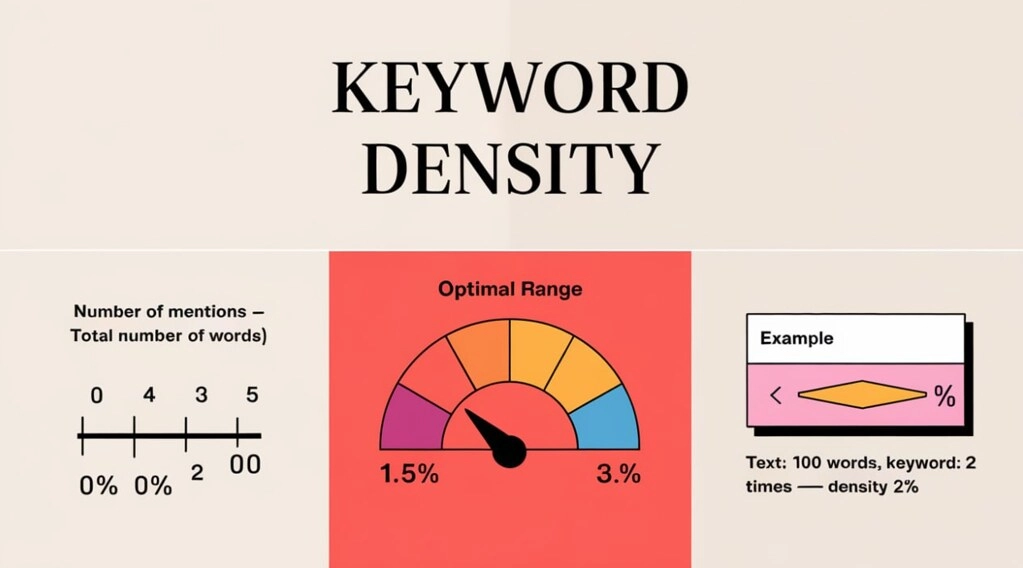
Creating SEO-optimized text content is a complex task that involves taking into account a fairly large number of different factors. Such articles should contain value and usefulness for the target audience, be structured, and easy to perceive. This is the only way to get materials that will be well received by the audience, will be easy to read, and will also show good results in ranking. One of the mandatory points that must be taken into account when preparing SEO-optimized content is keyword density. This characteristic reflects the percentage of keywords in the text content and indicates compliance with search engine requirements.
In today's review, we will get to know such a characteristic as keyword density in more detail and tell you how to calculate it. We will provide figures that are considered the norm today. We will describe in detail the accompanying indicators that are also worth taking into account. We will provide examples of services that you can use to quickly and easily find out the density of keywords in your text. We will provide a number of additional recommendations that will initially allow you to create content with optimal indicators of this parameter. If you take them into account, you will minimize the time and effort spent on making adjustments to the materials in the future.
It would also be useful to familiarize yourself with the principles of SEO at the stage of website creation, which will allow you to complete the upcoming work as correctly as possible and immediately launch your site into operation, receiving maximum efficiency in a short time.
What is keyword density
To determine the density of keywords in a particular text content, you need to divide the number of occurrences by the total number of all words and multiply the resulting figure by 100%. Let's say you have a 1000-word article about solar power plants. The main query "solar power plants" occurs 40 times in this text. As a result, the density of key queries will be as follows: (40/1000) x 100% = 4%. In most cases, this figure can be called optimal, but still, much depends on the specifics of the project itself, as well as on a number of related points.
To ultimately obtain a text with optimal key query density indicators, it is worth using the following recommendations:
- SEO specialists in most projects recommend keeping the keyword density in the range from 1% to 3%. But still, much here depends on the subject of the text, its length, as well as the requirements of the search engines through which this publication will be promoted. In most cases, for every 100 words, on average, there should be 2-3 repetitions of the key query. And if we return to the example with solar power plants, then here, along with such a request, related phrases are also very often used, such as "solar battery", "SES", "solar panel", etc. All these phrases in the text will alternate with each other, and as a result, the density indicators for each of them will most likely be in the range of 1% -2%. On average, it is recommended to make approximately 3-6 repetitions of key queries for every 150-200 words.
- Search engines are gradually complicating their own algorithms, making more and more demands on the quality of content. And here it is very important to maintain an optimal balance of key queries. Their number should be sufficient to ensure effective ranking. If the density of keywords ultimately turns out to be less than 1%, then with a high degree of probability you will not be able to get into the TOP of the search results for such a target request. Search engine bots will recognize such a page as irrelevant and will give preference to other resources. In any case, it is important to make sure that the main query is the most frequently used in your text compared to other words. Only then can we talk about its relevance for search engines.
- Avoid excessive keyword entries. For effective promotion of a certain page, it is also important not to overdo it with the number of keywords. If you decide to stuff your text with such queries in order to increase its visibility in search engines, you risk falling under a special search engine filter. In particular, we are talking about Google Panda, which will literally reject sites and not add them to search results due to excessive optimization and lack of semantic load. That is, excessive inclusion of keywords will indicate to the system that you are creating content not for people, but directly for bots, which will lead to blocking and restrictions.
But in parallel with the density of keywords, when preparing text content, it is imperative to take into account the related parameters, which we will talk about further.
Indicators directly related to the density of keywords
If you want to track the density of your keywords with high efficiency, while maintaining good relevance indicators of text content, then you should also pay attention to the related characteristics:
- Overspam.
- Nausea.
- TF-IDF.
- LSI queries.
Now we will consider each of these indicators in detail, tell you what they are responsible for and give examples.
Overspam
Keyword stuffing or overspam is a parameter indicating excessive use of different variations of key queries in the text. It has a negative impact on the quality of information presented in the publication, has a negative impact on SEO promotion.
A striking example of overspam is the following text: “If you are looking for stylish winter clothes, contact our online store. In the product catalog of the online store you will find winter clothes for women, men, children of different ages. Winter clothes from our online store are a combination of quality, style, exclusivity. In such winter clothes you will feel warm and comfortable even in severe frosts. Place an order for winter clothing in our online store now and get an additional discount.
As you can see, this paragraph very often contains the phrases “winter clothing”, “online store”. It seems like the meaning is clear here, but still the text does not look natural, it is poorly perceived, difficult to read. That is, the main problem here is the excessive presence of keywords. At least 5 phrases here can be removed or replaced with synonyms, thereby improving the quality of the text for both search bots and people.
Nausea
Keyword overuse or nausea is an indicator of excessively frequent repetition of certain words or phrases. Unlike the previous version, here we are talking not only about keywords, but also about any other expressions. As a result, a feeling of artificiality is created, the perception of the content is complicated. Most often, high nausea is observed in materials on technical topics, that is, where it is not possible to find synonyms for certain terms. But still, authors often make mistakes, inserting the same words of a phrase without obvious need.
As an example of a text with increased nausea, we can cite the following passage: “Buying stylish winter clothes from us is very easy. You can buy our clothes for children and adults, adding style to their everyday look. New winter clothes from our online store are stylish and sophisticated looks for every day. We know that you will be satisfied with our clothes.”
As you can see, words such as “clothes”, “our”, “style, stylish” are very often repeated here. As a result, the text itself looks too boring, monotonous, and uninteresting to read.
TF-IDF
Term Frequency-Inverse Document Frequency literally translates as term frequency - inverse document frequency. This is a technique based on which you can determine the importance of each individual keyword in a given text relative to the indicator for other articles on the same topic. That is, when conducting a TF-IDF analysis, the page of your site and the article posted on the pages of competitors in the top positions of search results are compared. To calculate this indicator, you need to do the following:
- Enter your main keyword in the search bar and open the first 5 sites in the search results. You can also take more or less resources, but fairly accurate TF-IDF indicators can be obtained from the TOP-5.
- Divide the number of term repetitions in each text by the total number of words in the text to determine the TF indicator, that is, the term frequency. Let's go back to the example with solar power plants. If the phrase "solar power plants" occurred 40 times out of 1000 words, then TF = 40/1000 = 0.04.
- Calculate the IDF, that is, the inverse document frequency as the logarithm of the ratio of the total number of documents to the number of documents where your keyword occurs. Add 1 to the resulting figure. Let's assume that the phrase "solar power plants" was found in 4 texts out of 5 selected ones. As a result, IDF = log (5/4) + 1 = 1.097.
- To calculate the TF-IDF value, we need to multiply both of these indicators. In our case, we get: TF-IDF = 0.04 x 1.097 = 1.13.
If we end up with an indicator greater than 1, then we can confidently say that this key request is important for the subsequent SEO promotion of this page. But still, you should not get too hung up on this parameter, since depending on the subject of the site, the number of terms used, this indicator can vary in a very wide range, starting from very low values, literally 0.01 and up to 10, or even more.
LSI queries
In parallel with the main key phrases, it is also recommended to add LSI queries to the texts. These are words or expressions that expand on this topic, help to reveal it, complement the text, make it simpler and more natural in perception, easy to read. If we return to the example with solar power plants, the following phrases can be used as LSI queries:
- solar battery;
- sun;
- installation;
- order;
- private house;
- buy;
- ground installation;
- roof installation;
- electricity;
- solar energy, etc.
Here the list can be very long. It is noteworthy that LSI queries practically fit into the text themselves, that is, they do not require their forced entry. Thanks to this, the publication looks natural, harmonious, interesting.
We also recommend paying attention to such an issue as technical SEO, because without complying with certain standards and requirements of modern search engines, you will not be able to provide your site with high positions in search results, or generate stable organic traffic to the site.
The best services for determining the density of key queries
We hope that now you understand how important it is to track the density of key queries. But performing such calculations manually in practice will not be very convenient, despite the fact that the calculation itself is elementary. And there is no point in this, since today there are many specialized services that will help you get the necessary data with literally a few clicks. Now let's take a closer look at the most popular and easy-to-use services.
Istio
Istio is a service that allows you to analyze the density of key queries, as well as other parameters that will be useful when conducting semantic analysis of texts. Basic functions are provided here for free, while you will need to pay for using advanced functionality. Users speak positively about the simple and convenient interface of the service. All that is required to start the check is to add the text itself in the appropriate field and click on the "Analysis" button.
If, along with the density of keywords, you are interested in other indicators, you can find out more detailed information about them directly in the list itself. To do this, simply hover over the green question mark “?”.
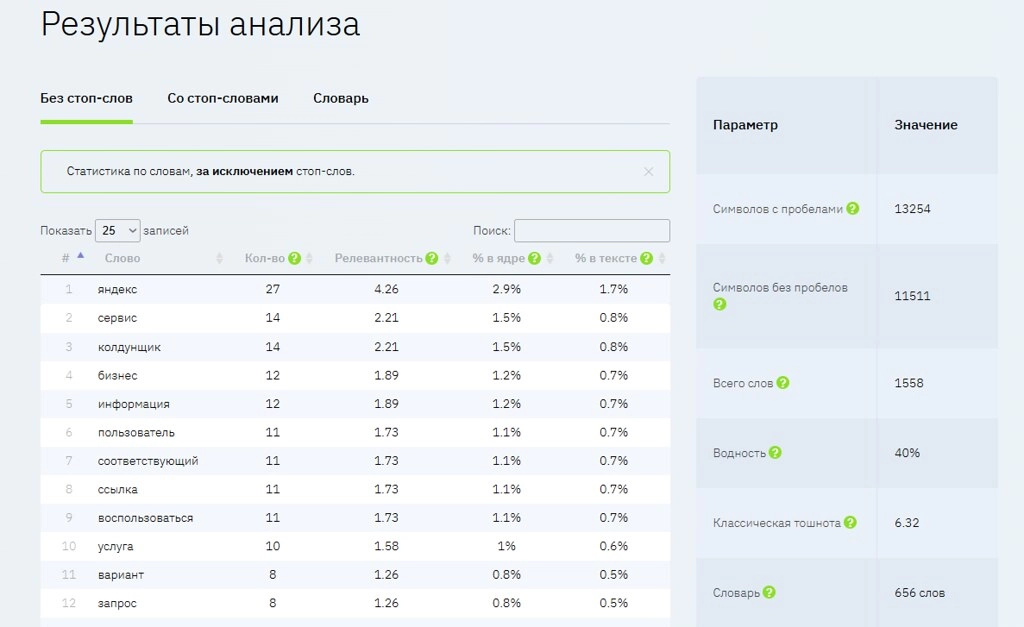
If you have already posted an article on the site pages, you can add the link itself to the service in the corresponding window, and then click on the “Add all text” button. The results of checking both through the text and through the link will be identical.
Serpstat
Serpstat is a fairly advanced text analytics service that allows you to perform advanced content analysis, including determining keyword density, analyzing competitors, monitoring site positions on both desktop and mobile devices, clustering keywords, tracking site traffic, and more. Among other things, this service analyzes the inclusion of keywords not only in the text on the page itself, but also in its Title, H1, and displays the significance of the phrase for a certain topic.
To use this tool, you need to add your semantic core to the service and cluster it. Based on the information received and the added site page, perform an analysis of keywords. We would like to draw your attention to the fact that only one page of your resource will be linked to the cluster, since you are asking specific queries. That is, the service will find it itself.

We would like to draw your attention to the fact that the service only provides 6 days of free use, after which you will need to purchase one of the tariff plans that suits you:
- Individual. It is intended for individual use, but it can also be used by small businesses. The cost is $60 per month of use.
- Team. Suitable for teamwork and small agencies specializing in SEO website promotion. The cost is $120 per month of use.
- Agency. It is aimed at large companies, corporations, whose work involves compliance with strict requirements for data volumes. Here, along with basic text analytics tools, there is also the ability to monitor site positions, analyze key queries, competitors, links, perform a site audit, etc. The cost is $492 per month of use.
Smallseotools
Smallseotools is a free and fairly easy-to-use service that allows you to determine the density of key queries. To start the check, you must initially select Word Counter (word count) from all the proposed tools, and then paste the text into the empty window or upload it, indicating the path to the corresponding file to the program, and then click on the "Word Count" button. As a result, you will receive a table containing general information on this text, including statistics on the use of keywords.
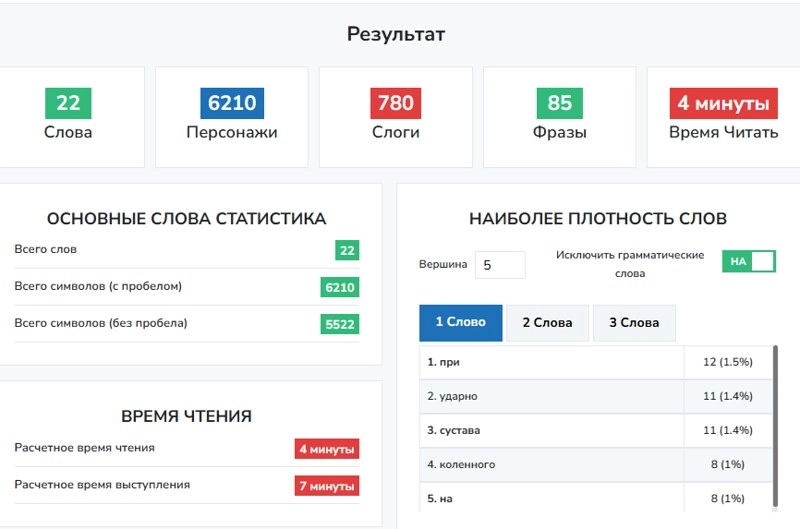
Here you can get information on keys consisting of one, two or three words, which may be required for a more comprehensive and in-depth analysis.
Wordcounter
Wordcounter is an extremely simple and one might even say basic tool for counting the number of words, characters in the text, as well as performing a density check of keywords. It works online, completely free. To use it, you just need to paste your content into the appropriate window. You won't even have to click any buttons to run the check. As a result, you will receive a table with the check results.
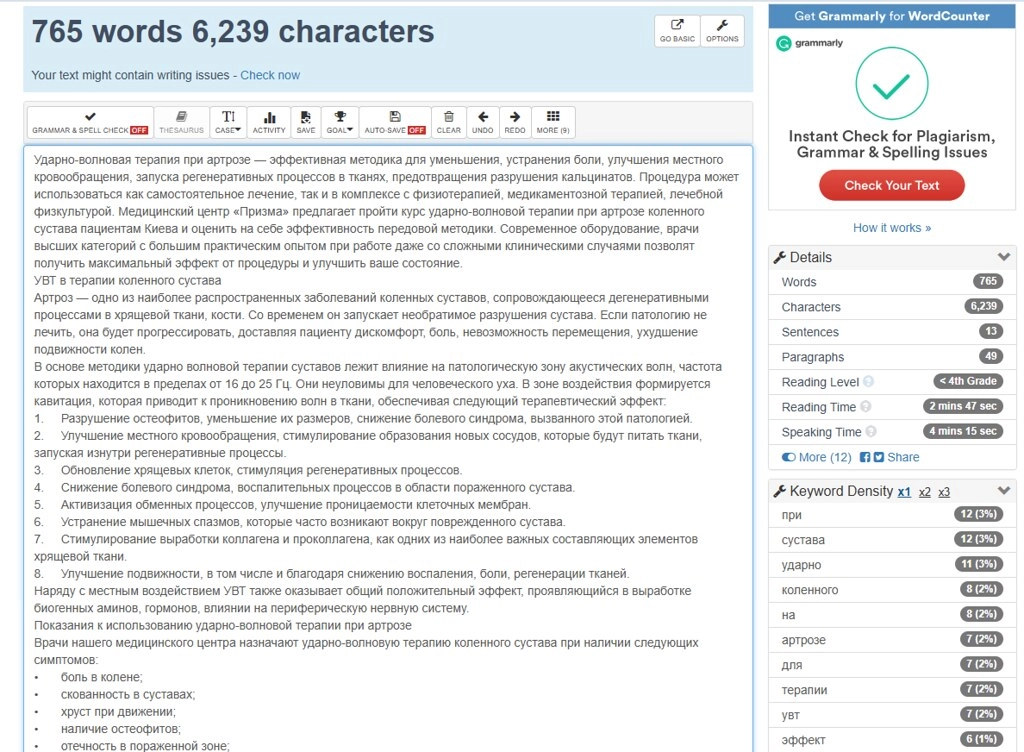
We would like to draw your attention to the fact that Wordcounter can contain information about keys consisting of not only one, but also two and even three words.
Simple SEO Tools
Simple SEO Tools is another free tool in our selection that allows you to perform a fairly accurate and subtle analysis of the text, including checking the density of keywords in the text. You will also be able to see how correctly they are located on the page. If necessary, you can manually enter your key queries, as well as additional LSI phrases. If you do this, the metrics for them will be displayed at the top above the main check.
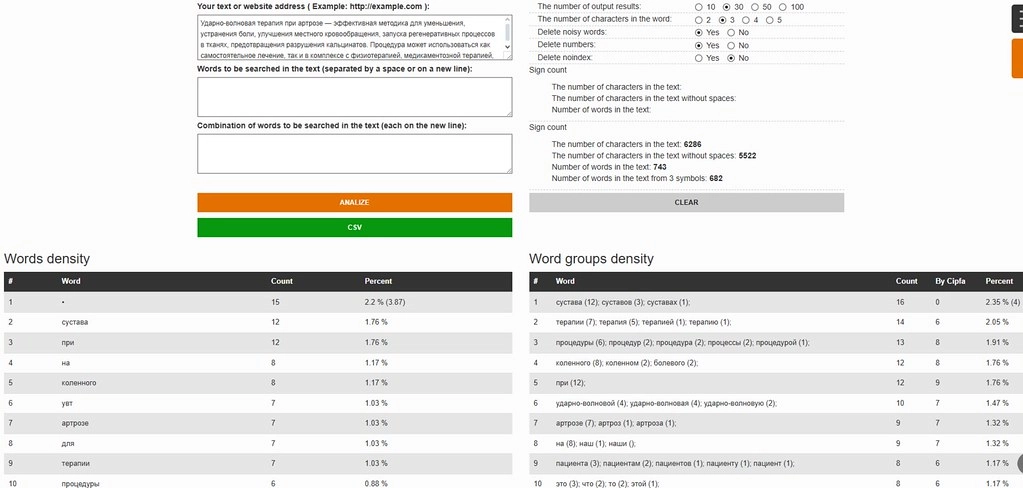
You can also optionally set up personal settings, such as excluding numbers or words that do not carry any semantic load, including conjunctions, prepositions, etc.
Hyperhost
Hyperhost is a service that will allow you to check the density of key queries. Please note that there is no button to start the analysis. If you insert text using a keyboard shortcut, such as Ctrl+V, the check will be automatic. But if you decide to insert via the context menu, that is, by clicking the right mouse button, you will need to press the Enter button on the keyboard. Without this, the tool will not work. We would also like to draw your attention to the fact that the word density is given here in quantitative terms, while the percentage is not provided.
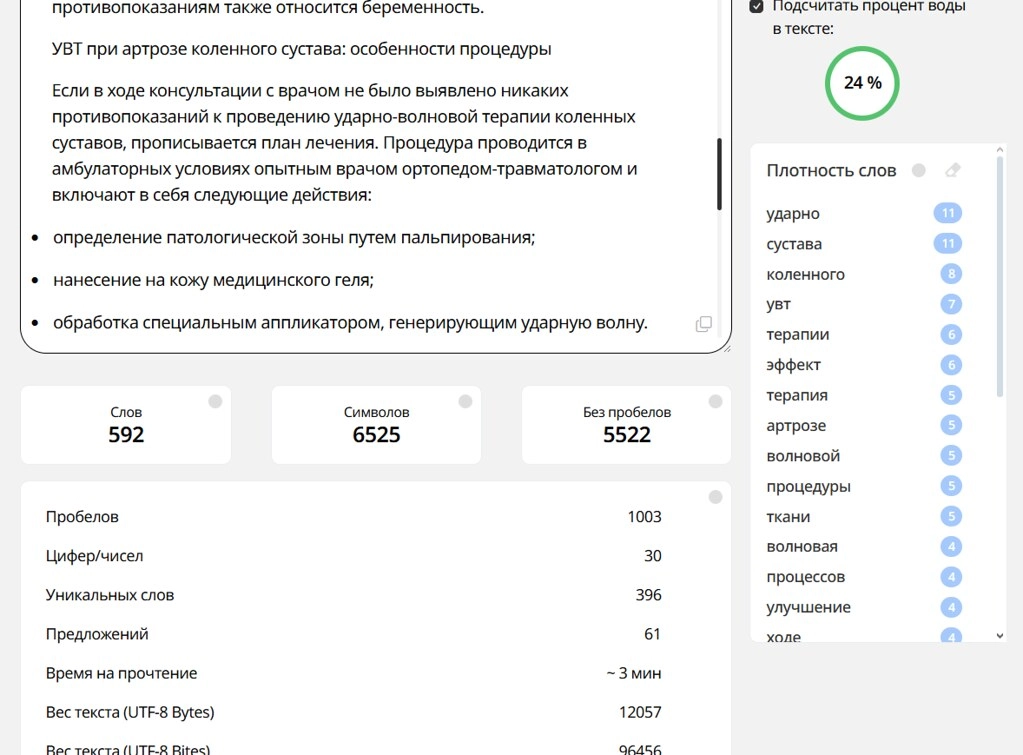
The following points are worth highlighting from the advantages of this service:
- information about the water content of the text, as well as the color highlighting of this indicator: green - within normal limits, yellow - it is advisable to make adjustments, red - need to change the text;
- clicking on any key request in the list will cause the corresponding word or phrase to be immediately highlighted in the text: it will allow you to see the moments where nausea is increased and quickly make adjustments;
- free and easy to use.
SEOquake
SEOquake is a fairly popular browser extension that allows you to check website pages for keyword density, spam, and analyze competitors' content. You don't even have to insert the text itself for checking. It will be enough to click on the plugin icon directly from the page you want to launch for analysis.
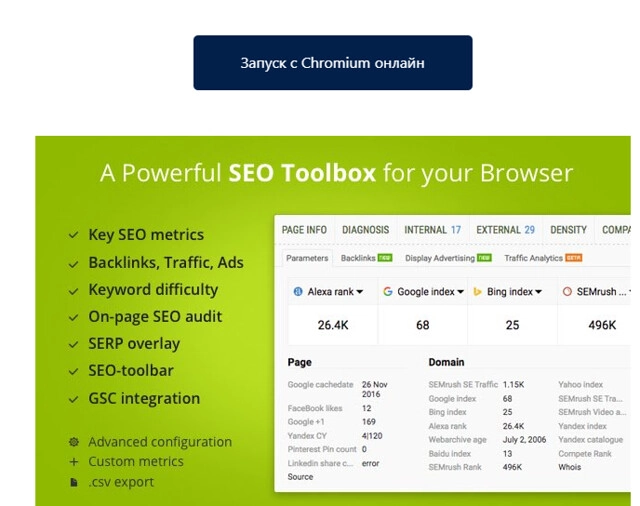
The main advantages of this tool include:
- display of information about which meta tags keywords were used: the T marking will indicate the title, D - the description, and H - on the header;
- providing information about the content of meta tags, as well as general information about the analyzed page, including its title, description;
- the presence of a filter for sorting key queries, selecting those that require individual verification;
- assistance in forming the so-called keyword cloud, where different phrases will be displayed in different sizes based on the frequency of their use in the text;
- free use subject to prior registration.
Here you will really find a wide range of tools for analyzing text content, including searching for entered keywords and their word forms, synonyms, context.
Neuralwriter
Neuralwriter is a fairly powerful tool for working with content, allowing you to analyze the density of key queries, as well as make appropriate changes to the content, following current SEO standards. In combination with good functionality, the interface here is quite simple and logically built. At the same time, you can see the results of checking for key queries consisting of 1, 2 or 3 words.
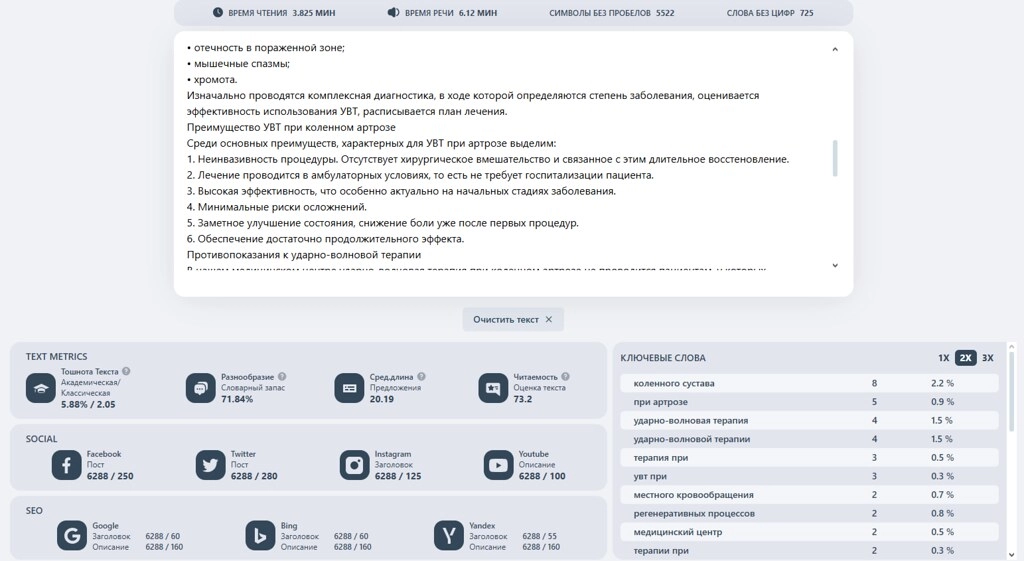
You can use all Neuralwriter tools absolutely free and without registration, including keyword density analysis, uniqueness check, paraphrasing.
Additional recommendations for writing texts with optimal keyword density indicators
To get a really high-quality text in practice, one that will be highly appreciated by search bots and regular users, you will have to put in a lot of effort and time. It will be necessary to monitor a large number of indicators, including the density of keywords. Here are some simple recommendations that will allow you to minimize adjustments later and do all the work as correctly as possible from the very beginning:
- Any text should initially focus on the target audience, and not on search bots. This means that it is important to pay attention to its usefulness, interestingness, and value for people. It should be easy to perceive, comfortable to read, and also fully disclose the topic and correspond to the queries entered by the user.
- No one will tell you what the exact percentage of keywords should be for the text, because there is no universal solution here. Everything is individual for each individual material. Therefore, SEO specialists often provide a fairly wide range for keyword density.
- Along with keywords in direct form, also use diluted occurrences, word forms, additional words. This is what will make the text more readable, easier to perceive, and will allow you to attract the audience's attention to small details. Do not abuse a large number of direct occurrences of keywords, because this can become one of the main reasons for spam, which can cause serious harm to a single page and the site as a whole.
- If in the check results you see that the density of key queries is too high, then you will need to delete repeating phrases or replace them with synonyms, dilute them with additional words. Thanks to this, you can avoid spam, preserve the value of your publication, and also increase the relevance of the content as a whole. Today, there are many specialized services that will help you select synonyms for key queries. In any case, it is important to avoid unnatural expressions, constructions in a sentence. It is better not to include a direct clumsy query in the text, modifying it, than to leave it as it is.
- You have compiled a semantic core and you have quite a lot of phrases in it, but at the same time you would like to preserve all of this as much as possible? Consider increasing the volume of the article. If you have 15 keywords per 1000 words, then for quality this will be much better than the same 15 phrases, but per 200 words. This way you will maintain the readability of the publication, improve loyalty from the target audience, and be able to avoid blocking and restrictions from search bots.
- Distribute keywords as evenly as possible throughout the text. Be sure to add them to the H1, H2, H3 headings. The main phrase should be written in the first paragraph, which will give a quick signal to search bots. Also leave one keyword for the last paragraph, as if summing up. Distribute the remaining phrases evenly throughout the body of the article, thereby ensuring the most natural reading of the material.
As you can see, there is nothing complicated or impossible to implement in these recommendations. But the effect will be more than impressive. Use these tips and see for yourself.
Let's sum it up
Keyword density is one of the really important indicators that should be taken into account during SEO optimization of sites or the initial preparation of content for filling online resources. It must be constantly monitored, since the success of promoting the corresponding page in search engines directly depends on it. In parallel with this, also pay attention to the nausea of the text, watch out for overspam, add LSI phrases, measure TF-IDF. This is the only way you can get really high-quality content at the output. We also introduced you to the services with which you can find out all the necessary data or perform calculations.
Mobile proxies from the MobileProxy.Space service will provide significant assistance in collecting the semantic core, analyzing competitors, parsing data, monitoring the effectiveness of SEO promotion and performing related work. With their help, you can replace the real IP-address of your device and its geolocation, thereby bypassing regional restrictions and access blocking. You will also be able to use tools that automate actions on the network, avoid bans from social networks and many other platforms. And you also guarantee yourself high levels of privacy and security when working on the Internet.
At the link https://mobileproxy.space/en/user.html?buyproxy you can study detailed information about what these mobile proxies are, evaluate the availability of tariffs, take advantage of free testing for 2 hours. Also at your service will be a competent technical support service, working around the clock.